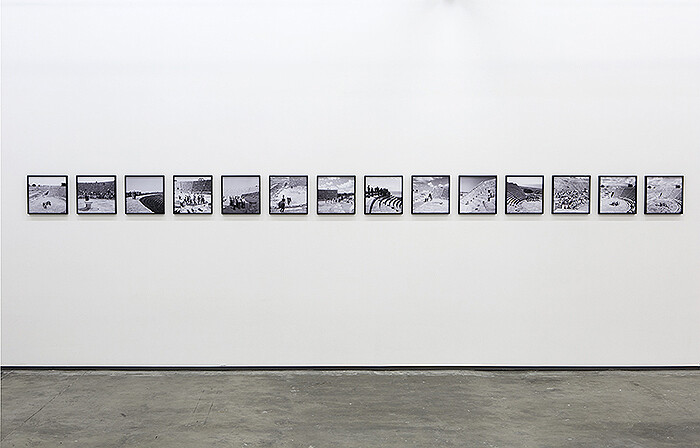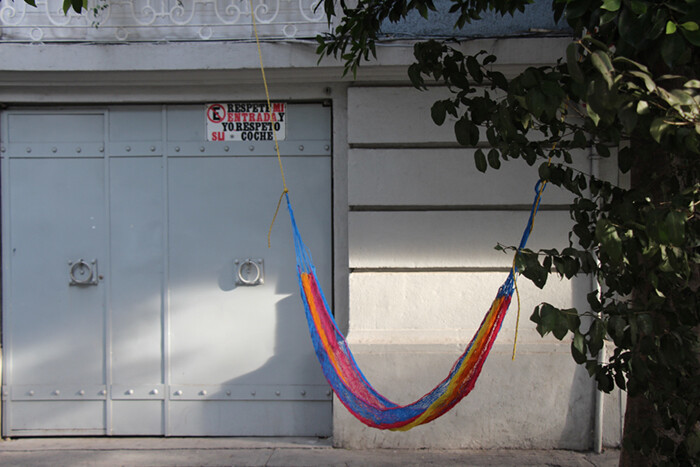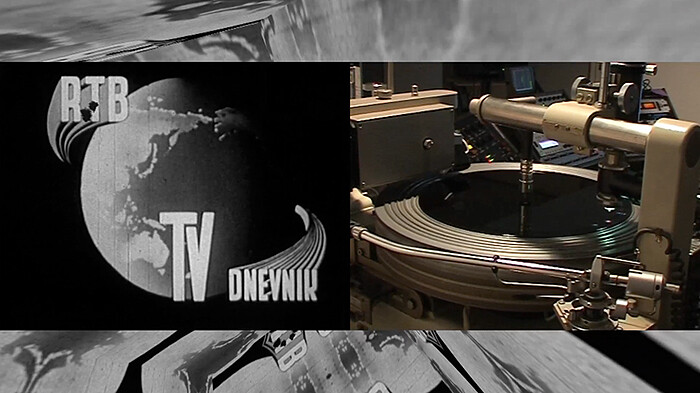Categories
Subjects
Authors
Artists
Venues
Locations
Calendar
Filter
Done
July 31, 2014 – Review
Daniel Steegmann Mangrané’s “/____/_//__”
Ana Teixeira Pinto

The Phasmida are an order of insects whose rocking march always seems hesitant. Every step they take, “stick insects”—as Phasmida are commonly called due to their resemblance to sticks or leaves—will reluctantly stretch out a leg, making cadenced, side-to-side movements as if tentatively rehearsing the next. Biologists will tell you their intention is to remain inconspicuous by mimicking the rustling of twigs, but perhaps they are simply world-weary.
In his 16mm film Phasmides (2012), Spanish-born, Brazilian-based artist Daniel Steegmann Mangrané trails a stick insect’s journey inside his own studio. Initially shot against a cluster of branches and foliage, the insect slowly sways out of its den. It makes its way across the floor and onto a table filled with primary structures and geometric patterns that reflect the formal vocabulary of modern art from Constructivism to Minimalism. Assuming the liveliness of these fixed geometries, the stick insect then blends into a background reminiscent of a Carl Andre or a Sol LeWitt.
Contrary to British naturalists Charles Darwin and Alfred Russel Wallace’s notion of an evolutionary adaptive value, Surrealist writer Roger Caillois described mimicry as a surrender to the “lure of space,” a “scattering of self across landscape,” rather than as a defense mechanism.(1) …
July 25, 2013 – Review
“A Trip to the Moon”
Chris Sharp

Despite the possession of a rich literary pedigree, the good old chicken-or-egg quandary of fact or fiction seems to receive limited play if not in the Latin American context, then the Mexican context of contemporary art (and by literary, I mean of course Julio Cortázar, and even more importantly, Jorge Luis Borges, who reveled in this mental stew regularly). Why is this? Well, beyond its origins in the critical re-evaluation of the promises of modernism, the theme seems to be the banal luxury of more politically stable climes, more at home in, say, Western Europe than in a region awash with unprecedented drug cartel violence and the albatross of responsibility that attends it. Given these conditions, such literary antics are liable to come off as politically irresponsible, all but rendering such ontological speculation a blithe, bohemian enterprise.
This charming group exhibition, curated by Fabiola Iza, manages to both sidestep and problematize such conceivable, context-specific political incorrectness by offering what could be perceived as a more nuanced perspective on said quandary. Entitled “A Trip to the Moon,” the show is positioned in-between two moments—the 1969 landing of Apollo 11 on the moon, a historic feat apparently riddled with doubt, and Georges Méliès’s …
April 16, 2013 – Review
Mexico City Dispatch: Zona Maco Sur and Gallery Openings
Gabriela Jauregui

The Zona Maco art fair week (April 10–14) got off to a good start with the notion of a nude bird at Etienne Chambaud’s exhibition at LABOR called “The Naked Parrot.” The path was there, the bird absent. Rainbow-colored bird shit, echoed in the emailed invitation image of multicolored pigeons, outlined a zigzag trajectory through the gallery, under a fragile crisscross of severed bronze heads punctured by steel beams, titled The Fractal Zoo (2013). It left us to wonder: who are the animals inside this gallery-turned-cage? The yellow-pink-orange-blue-green shit road (from pigeons which the artist had fed colored pellets) marked an auspicious beginning for the journey that would end at Maco itself, a journey which included a fauna of art goers from all over the world teetering through Mexico City, from one opening to the next, in high heels and spring suits.
But it was last Tuesday that truly marked the gallery opening marathon, starting with Edgardo Aragón at Proyectos Monclova. The highlight of his show, which focused on land rights and violence, mostly in his native state of Oaxaca, was what the artist called his “portrait” of Zapata, titled, appropriately, Zapata (2013): a black marble box containing earth from the …
March 21, 2012 – Review
Aleksandra Domanović & Sharon Hayes
Catalina Lozano

Aleksandra Domanović’s practice analyzes socio-political transformations through the production of images and narratives largely based on popular culture. By decontextualizing and reconfiguring media content, Domanović delves into the accumulative nature of information and its intrinsic indexicality. Like many artists born on the communist side of the Iron Curtain, she is interested in the difficult transition towards capitalism and the emergence of new social values, and, in specific, in the case of former Yugoslavia (where she was born), how this is all exacerbated by the outbreak of an ethnic and nationalist war.
At Proyectos Monclova, Domanović presents 19:30 (2010–11), a two-channel video projection which articulates two heterogeneous sets of imagery: the opening titles of several regional news networks of the former Yugoslavia and a stream of shots of techno raves, which emerged in the same region, like in many other places in the 1990s, as a strong part of youth culture. This unlikely marriage of references is materially and conceptually made possible through the soundtrack, a remix of the news jingles made by techno DJs. While the series of opening titles evoke the socialist era of information distribution, the raves manifest forms of collective social venting in this “new” society.
Watching the work, …